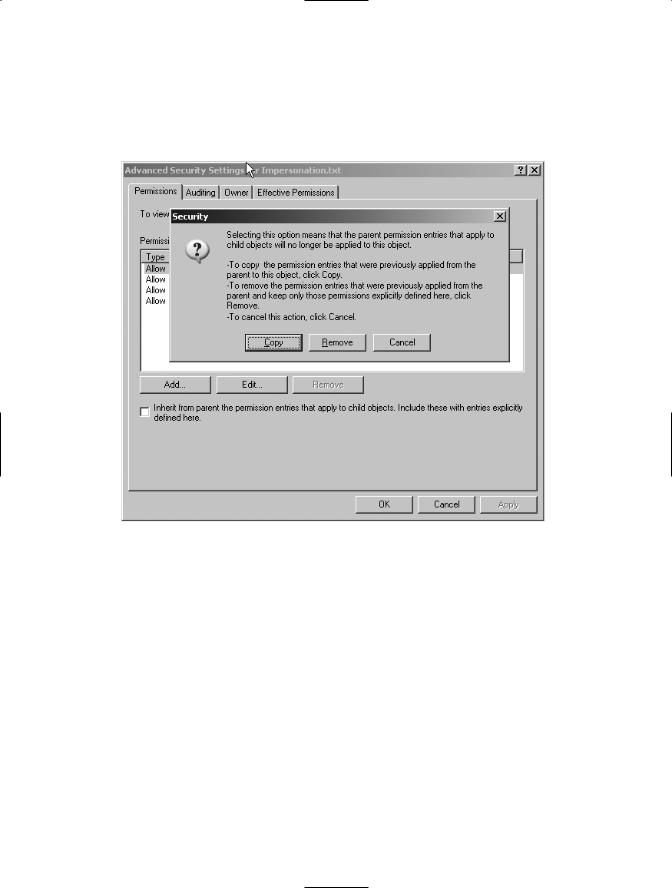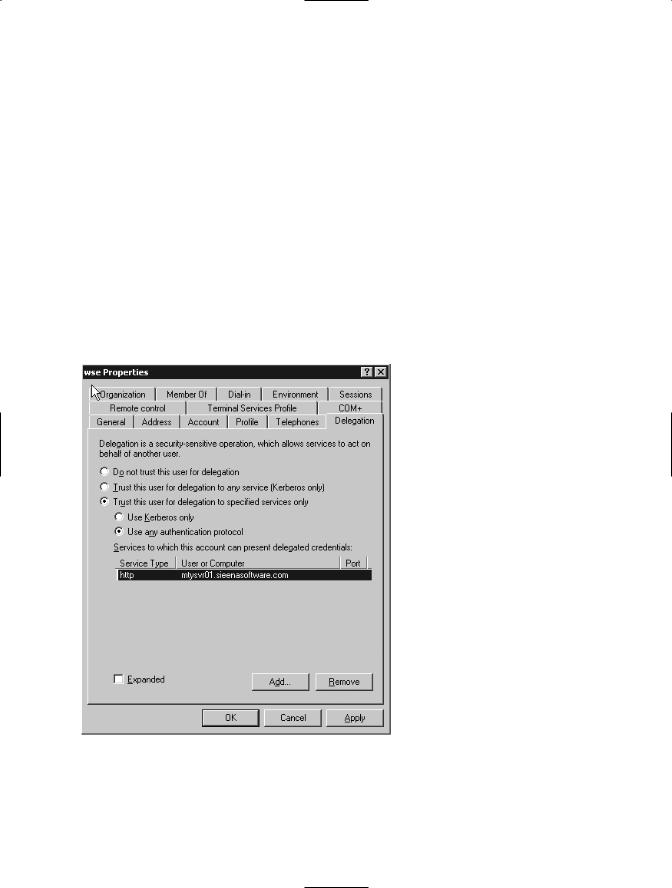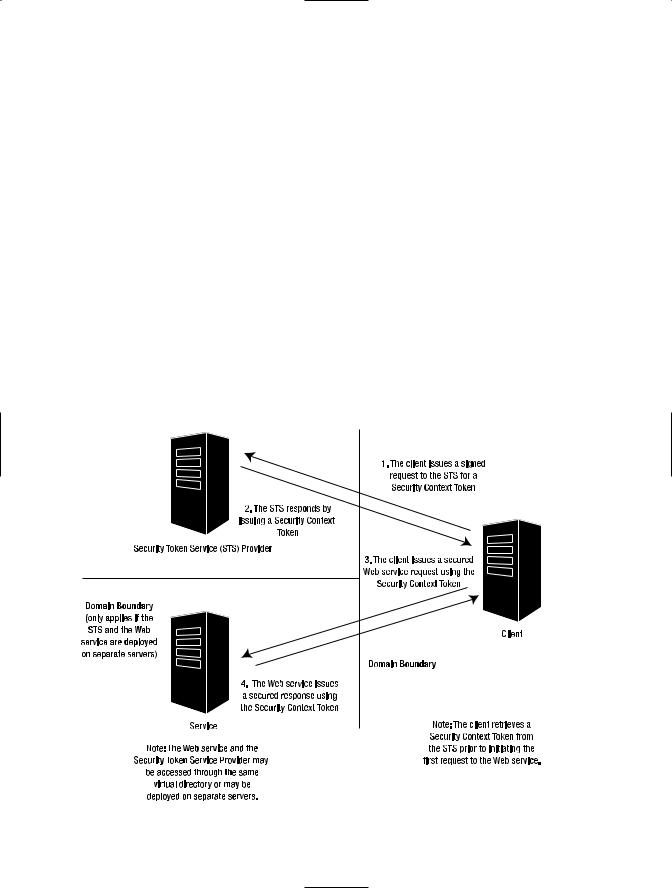
Expert Service-Oriented Architecture In CSharp 2005 (2006) [eng]
.pdf
156C H A P T E R 7 ■ E X T E N D E D W E B S E R V I C E S S E C U R I T Y W I T H W S - S E C U R I T Y A N D W S - S E C U R E C O N V E R S AT I O N
4.In the Advanced Security Settings dialog, uncheck the Inherit from Parent the Permission Entries box.
5.In the Security pop-up window, click the Remove button, shown in Figure 7-11.
Figure 7-11. The Advanced Security Settings dialog
6.Click OK on the Advanced Security Settings dialog. You will get a prompt asking you if you want to remove all the users from the list. Click Yes. You are going to add a new user with read permissions in the next step.
7.In the Security tab, click the Add button and enter the name of the client user that you are going to authenticate at the server. Use the domain\username format.
8.Make sure the user has read access to the file and click OK.
This file will help you validate whether the impersonation is taking place. Remember that this service is running under a domain account different from the one that you used to log on to the client computer. So if impersonation doesn’t take place, the following code will not be successful:

C H A P T E R 7 ■ E X T E N D E D W E B S E R V I C E S S E C U R I T Y W I T H W S - S E C U R I T Y A N D W S - S E C U R E C O N V E R S AT I O N |
157 |
private void impersonate(KerberosToken token)
{
if (token.Principal!=null && token.Principal.Identity is WindowsIdentity)
{
//Obtain user identity WindowsIdentity callerIdentity =
token.Principal.Identity as WindowsIdentity;
//Initialize context object WindowsImpersonationContext context = null;
try {
// Impersonate the user
context = callerIdentity.Impersonate();
// Access a file that only this user has permissions to read FileStream x = File.OpenRead("c:\\temp\\Impersonation.txt"); x.Close();
}
catch (Exception ex)
{
// rethrow the exception throw ex;
}
finally
{
context.Undo();
}
}
}
Add a line at the beginning of the RequestQuote method that passes the Kerberos token to the Impersonate method.
impersonate(RequestSoapContext.Current.Credentials.UltimateReceiver. GetClientToken<KerberosToken>());
This method starts by obtaining the user’s identity from the Kerberos token, and then it impersonates the user by setting its identity in the current security context. After the user has been impersonated, the code opens the Impersonate.txt file and it immediately closes it. If the user is not impersonated successfully, this line will cause a SystemUnauthorizedAccess exception.

158 C H A P T E R 7 ■ E X T E N D E D W E B S E R V I C E S S E C U R I T Y W I T H W S - S E C U R I T Y A N D W S - S E C U R E C O N V E R S AT I O N
The impersonation code has to be implemented within a try, catch, finally block. The goal is to restore the original security context after the file has been read or after an unexpected error.
Impersonation can also be achieved by adding the following line at the web.config file. However, this applies to all the methods in the Web service and it doesn’t allow you to impersonate a user only for a particular task:
<identity impersonate="true" />
Constrained Delegation
There is another feature provided by Kerberos that is named Constrained Delegation. This feature allows the impersonated client user to access a resource on a different machine. The service user that will be performing the delegation needs to be configured in Active Directory. This configuration consists of choosing a list of services that the user is authorized to delegate on. In Figure 7-12, the WSE user is authorized to delegate credentials to the HTTP server of the MTYSVR01 computer.
Figure 7-12. Delegation properties tab in Active Directory
You have the option to trust the user for delegation to any service. This is known as Unconstrained Delegation but it is not recommended because if the security of the service is compromised it means that all the services in the network are also compromised.

C H A P T E R 7 ■ E X T E N D E D W E B S E R V I C E S S E C U R I T Y W I T H W S - S E C U R I T Y A N D W S - S E C U R E C O N V E R S AT I O N |
159 |
Prevent Replay Attacks Using Time Stamps, Digital Signatures, and Message Correlation
We will continue this chapter with a look at a different kind of security issue called replay attacks. A replay attack occurs when a client makes multiple Web service calls to the same service without waiting for a response from one or more previous requests. If enough of these calls are made, it is possible to overwhelm the Web service’s hosting server, and to then cause the service to become unresponsive or to go offline. Replay attacks are at best a nuisance and, at worst, can cause critical system breakdowns.
The WS-Security specification mentions replay attacks and briefly describes a strategy for dealing with them. The key to preventing a replay attack is for a Web service to monitor the status of incoming messages and to verify their uniqueness. The Web service needs to verify that an incoming SOAP request message is unique and has not already been sent before the service starts processing the message.
■Note You can eliminate replay attacks by unauthorized clients by using an encrypted communication channel such as Secure Sockets Layer (SSL). However, SSL provides no protection if the authorized client decides to conduct a replay attack. Other protective measures are required. The strategies that are outlined in this section assume that you want to prevent replay attacks by verifying request messages for uniqueness and verifying that they have not been tampered with.
Standard Web service calls are stateless, and SOAP messages are inherently stateless oneway communications. SOAP messages must therefore include extra information that tracks their uniqueness and thereby helps the service to verify whether a request message has already been received. There are three main ways to track this information and to enable message verification and protection against replay attacks:
•Message time stamps (including Created and Expires)
•Username Token nonce values
•Message correlation (including sequence numbers)
In the next sections we will consider each of these and how they can be used to secure SOAP messages, and Web services, against replay attacks.
Use Time Stamps for Message Verification
Message time stamps are added to an outgoing SOAP request message by the sender. They help in detecting unauthorized SOAP message requests. The client may choose to set an expiration date and time on the request message, which means that the message is only valid for a specific number of seconds after it is issued. This ensures that if the SOAP message is intercepted and re-sent by an unauthorized sender, it will only be useful to them for a limited amount of time. And, of course, if the message expiration is set short enough, there will not be time for an unauthorized party to intercept and reroute the message. Message time stamps

160C H A P T E R 7 ■ E X T E N D E D W E B S E R V I C E S S E C U R I T Y W I T H W S - S E C U R I T Y A N D W S - S E C U R E C O N V E R S AT I O N
and expiration are a useful first defense for preventing the unauthorized use of legitimate SOAP messages. As added protection, the client may digitally sign both the message body and the time stamp directly. This allows the receiving service to detect a scenario wherein the time stamp itself was tampered with and altered by an unauthorized user.
■Note SOAP message interception and tampering is a serious security issue that will become more widely understood (and worried about) once Web services become more commonly deployed and used by companies. If a thief steals your credit card or a document that contains your personal information, he has access to a legitimate source of credit, even though he is not an unauthorized user. SOAP message interception potentially creates the same security compromise scenario.
Once the service receives the request message, it can cache the SoapContext while it processes the message. Subsequent incoming request messages can then be compared against the cached SoapContext objects and rejected if the service detects that the request has already been received. Recall that the SoapContext is a WSE-specific class representation of a SOAP message and is a member of the Microsoft.Web.Services3 namespace. You can use the SoapContext class to programmatically access the properties of a SOAP message, including its headers and body.
There are no specific rules as to what kind of information you should use to correlate SoapContext information between messages. Basically, any unique identifying information makes for a good candidate, as long as it cannot be spoofed by an unauthorized third party. So you will want to choose a piece of information that can be digitally signed in the request message. Good candidates include addressing headers and security token IDs. In addition to addressing headers, you can correlate messages using specific contents of the SOAP message body, or any other header information that is uniquely set by the client. If the message uses a security token, the token itself can be used to uniquely identify a message.
Use Username Token Nonce Values for Message Verification
If you find yourself struggling to extract a unique piece of information from a message (using the SoapContext class), and the message includes a Username Token security token, you can use a nonce-based token ID as a unique identifier. A nonce is simply a random cryptographic string that can be assigned as the ID value for the Username Token security token. When the service receives a request message, it can extract the nonce value from the security token and cache the value for the duration of the request message. These ID values are part of the message signature and cannot be spoofed. And because they are nonce values, it is highly unlikely that two request messages will coincidentally share the same ID values. However, this could happen if you choose to rely on the autogenerated ID value for the security token.
Again, the burden remains on the service to cache information on incoming request messages. But if you need to take this approach, a nonce value is the simplest way to do so.
Listing 7-5 shows how the client can assign a nonce value to a Username Token security token.

C H A P T E R 7 ■ E X T E N D E D W E B S E R V I C E S S E C U R I T Y W I T H W S - S E C U R I T Y A N D W S - S E C U R E C O N V E R S AT I O N |
161 |
Listing 7-5. Assigning a Nonce Value to a Username Token Security Token
using Microsoft.Web.Services3.Security;
using Microsoft.Web.Services3.Security.Tokens;
SecurityToken token = new UsernameToken(username, passwordEquivalent, PasswordOption.SendPlainText);
// Assign a random nonce value to the security token Nonce objNonce = new Nonce(34);
token.Id = objNonce.Value;
You may be wondering why nonce values apply specifically to the Username Token security token. This is because other security tokens are more sophisticated and do not require the additional guarantee of uniqueness that a nonce value provides. A Username Token security token is, after all, simply a hashed username-password combination, and there is nothing inherently unique about this combination. Usernames and passwords can be duplicated between users much more easily than cryptographic values can, especially if a malicious client is intentionally using another client’s credentials.
If you use an alternate security token such as an X.509 certificate, you are automatically afforded some protection because the client and the service are using credentials that are not easily discovered. However, as we pointed out with SSL, this does not provide protection against replay attacks. You cannot assume that authorized clients will by their nature avoid carrying out a replay attack. For example, consider a client that autogenerates Web service calls in batch mode. If this client were to experience a system error or breakdown in business logic, it is conceivable that the client might generate duplicate request messages to the service. This is why you must tackle replay attacks at the message and service level. You cannot protect against replay attacks under the umbrella of a trusted relationship between client and service.
Use Message Correlation and Sequence Numbers for Message Verification
The key to preventing replay attacks is for the Web service to verify the uniqueness of incoming request messages. The WS-Addressing specification describes a GUID-based message ID that is one of several addressing headers that can be assigned to a SOAP message. WSE provides support for the WS-Addressing specification in general, and for addressing headers specifically. Once again, the burden is on the Web service to store message correlation information and to determine whether an incoming message has already been received. As with other kinds of identifiers, the message ID does not in and of itself prevent replay attacks, but it provides another simple, unique identifier for an incoming SOAP message.
Another type of message identifier is the sequence number, which stamps a message with the sequential role that it plays in a business process. Sequence numbers are part of the WSReliable Messaging specification and are designed to enable business orchestration, which refers to a business process or workflow that spans multiple components. In SOAs, sequenced messages are exchanged between multiple Web services, and the collective outcome represents the completion of the business workflow.

162 C H A P T E R 7 ■ E X T E N D E D W E B S E R V I C E S S E C U R I T Y W I T H W S - S E C U R I T Y A N D W S - S E C U R E C O N V E R S AT I O N
Sequence numbers provide an additional advantage for preventing replay attacks because a message that contains a duplicate sequence number is automatically suspect. Sequence numbers alone do not ensure uniqueness, but they will in conjunction with a message ID.
Establish Trusted Communication with WS-Secure Conversation
The WS-Secure Conversation specification allows Web services and clients to establish a token-based secure conversation for the duration of a session. It is analogous to the SSL protocol that provides on-demand secure communications over the HTTP transport channel. Secure conversations are essentially an efficiency mechanism to optimize the secure communication between a service and a client after the initial exchange of security credentials is over; this is known as the handshake. Secure conversations reduce the need for frequent authentication between client and service.
In previous chapters, you saw how the WS-Security and WS-Policy family of specifications combine to provide a comprehensive approach to securing Web services. Together these specifications provide an assortment of security options, including digital signatures, encryption algorithms, and custom authorization schemes. We discussed these technologies in the context of protective security, meaning that they protect messages in transit and keep unwanted eyes from discovering sensitive information. This is certainly an important application of these technologies and it needs no further explanation. But for the purpose of this chapter, we need to expand the context within which to view these technologies. They are no longer needed just for protective security; in a broader context, they are needed for establishing trusted communications.
In the discussions so far, we have made the big assumption that the client and the Web service automatically trust each other. By this, we mean the assumption that they both have an equivalent confidence in the integrity of the security tokens they are using to sign, encrypt, and otherwise secure their communications. For example, if a client and a Web service agree to encrypt their messages using a digital X.509 certificate, they must both trust the source of the certificate, and must be comfortable using the private and public keys that are generated from the certificate. In a sense, both the client and the Web service have come to a mutual agreement that they will offload the burden of proving trust to a (trusted!) third-party source, which issues a digital certificate to act as the tangible record of that trust.
Of course, the issue is more complex than this. When it comes to certificates, for many of us they are a necessary requirement for trusted communication. As clients, we may have all the trust in the world in a service provider, but we still need to use a digital certificate for the mechanics of signing and encrypting shared messages. We happen to be comfortable with digital certificates for most communication requirements because they represent certified trust. However, other client-service communications may be just as well off using a simpler Username Token security token, which is based on a simple username-password combination that gets hashed during transit. Luckily, the WSE implementation of the WS-Security specification is flexible, and you have a choice of security token types to use for conducting trusted communication.

C H A P T E R 7 ■ E X T E N D E D W E B S E R V I C E S S E C U R I T Y W I T H W S - S E C U R I T Y A N D W S - S E C U R E C O N V E R S AT I O N |
163 |
The point is that your preferred security tokens and your preferred hashing and encryption algorithms are simply a means to a bigger goal of establishing trusted communication, otherwise known in the Web services world as secure conversation. There is no single correct choice of technologies that you should always use. Instead, you need to be using those technologies that are appropriate for establishing a trusted, secure conversation between
a given client and a Web service. The rules can change depending on who is doing the communicating.
This chapter focuses on how you establish session-oriented, trusted communications using the WS-Secure Conversation specification. The great thing about the WSspecifications is that many of the concepts complement each other and build on each other. The understanding that you now have about WS-Security and WS-Policy will translate directly into the concepts behind WS-Secure Conversation. By the end of this chapter, you will have a good understanding of what constitutes secure conversation, and a broader appreciation for the usefulness of the WS-Security family of specifications.
Overview of Secure Conversation
The WS-Secure Conversation (and WS-Trust) specification provides the means for a client and a service to establish an optimized secure communication channel for a session, that is, an established duration of time. Secure conversation uses a security token that is procured by a service token provider following the initial handshake, or exchange of original security tokens, by the service and client. The security token is used to encrypt and sign all subsequent SOAP messages that are exchanged between the service and client. This process involves an initial amount of overhead, but once the channel is established, the client and service exchange a lightweight, signed security context token, which optimizes message delivery times compared with using regular security tokens. The security context token enables the same signing and encryption features that you are used to with regular security tokens.
Secure conversation is analogous to communications over the HTTPS protocol. HTTPS establishes a secure channel for the duration of a session and ceases to be in effect once that session is over. The classic example is an e-commerce transaction, in which you browse a catalog over an unsecured channel, but then you establish a secure channel for the purpose of completing a sales transaction with the vendor. The communication needs to be secure because sensitive payment and order information is being exchanged, so the client and the vendor need to establish a secured channel for as long as it takes to complete the transaction. For performance reasons, the client does not need or even want to establish a continuous secure session for every interaction with the vendor. HTTPS is useful for providing ondemand secure communication for exactly as long as it is needed.
■Note HTTPS and WS-Secure Conversation differ in one important way: HTTPS is not typically used for client authentication, whereas secure conversation is.

164 C H A P T E R 7 ■ E X T E N D E D W E B S E R V I C E S S E C U R I T Y W I T H W S - S E C U R I T Y A N D W S - S E C U R E C O N V E R S AT I O N
A secure conversation has the following characteristics:
•It is based on established security tokens, including Username Tokens and X.509 certificates.
•It uses a dedicated service token provider to generate a signed service context token, which is a lightweight security proxy.
•It provides a secure communication channel for the duration of the session.
•It provides optimized performance for session-oriented communications with multiple round trips (by using the security context token).
The difference between secure conversation and standard secure message exchange (with WS-Security and WS-Policy) is that a standard security policy framework establishes a fixed security policy that all service clients must adhere to. However, secure conversation has a more dynamic aspect. The client and service can initiate a secure channel as needed, rather than one based on an established policy framework. Secure conversation uses security tokens that are issued for the purpose of a specific communication. The service itself can act as the provider of these security tokens. Alternatively, this responsibility can be offloaded to a thirdparty service token provider, which is a dedicated resource that acts as a trusted intermediary between clients and services, and the issuer of security tokens for their secure conversations. Figure 7-13 provides an architecture diagram for typical secure conversation solutions.
Figure 7-13. Architecture diagram for a secure conversation solution

C H A P T E R 7 ■ E X T E N D E D W E B S E R V I C E S S E C U R I T Y W I T H W S - S E C U R I T Y A N D W S - S E C U R E C O N V E R S AT I O N |
165 |
In WSE 3.0 solutions the Web service will typically also act as the secure token service provider. Figure 7-13 shows the secure token service provider as a separate third-party service in order to distinguish this functionality from that of the Web service itself.
A secure conversation is initiated by a client that requires an on-demand secure communication session with a Web service. The session may be required for the duration of one request, or for several back-and-forth requests and responses between the client and the Web service.
The workflow for establishing and conducting a secure conversation as presented in Figure 7-13 typically follows four steps:
1.The client initiates the secure conversation by issuing a signed request to the STS provider for a security context token. The client may sign the request with any standard security token, including Username Token and X.509 certificates.
2.The STS provider verifies the integrity of the signed request. It then generates a security context token and delivers it to the client. The Web service itself can also act as the STS, or you can deploy the STS as a separate service. The security context token is actually returned from the STS as a so-called request security token (RST). The client can then extract the security context token from the RST. WSE 3.0 provides all of the support classes that you need to handle these tasks in code. Alternatively, you can simply reconfigure an existing turnkey security scenario to implement secure conversation with no code changes required. We will review how this is done in the next section, “How to Implement Secure Conversation Using WSE 3.0.”
3.The client issues a secured Web service request using the security context token.
4.The Web service issues a secured response using the security context token. The security context token can be used like any standard security token. It inherits from the same base classes, and its usage is no different from the security tokens you learned how to work with in Chapter 6. Security context tokens may be cached in a global cache for future retrieval, for example, when the client will be issuing multiple requests over a period of time.
Programmingwise, WSE 3.0 makes it very easy to implement a service token provider because the WSE infrastructure will automatically issue security context tokens. This feature is enabled by simply adding a configuration element to the service token provider’s configuration file. The STS provider can be incorporated into the client’s target Web service, or the STS provider can be implemented as a dedicated Web service. There is little difference in the code between a hosted service token provider (that resides in the client’s target Web service) and a dedicated service token provider (that resides on a separate domain). There are some significant configuration and deployment differences between the two models, but codewise they are very similar.
■Note The feature you know as Secure Conversation uses several WSspecifications, including WS-Trust, WS-Secure Conversation, and WS-Security. In addition, you can reduce code listings (and potential errors) by implementing policy frameworks for the participating services and clients. This chapter does not focus on when particular WSspecifications come into play. Instead, the focus is on understanding the concepts and discussing practical code samples.
